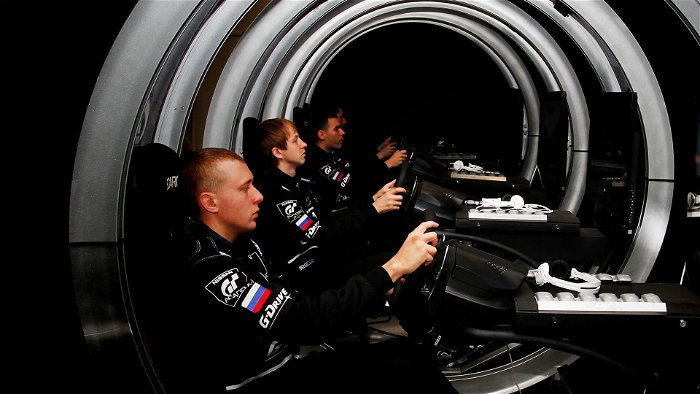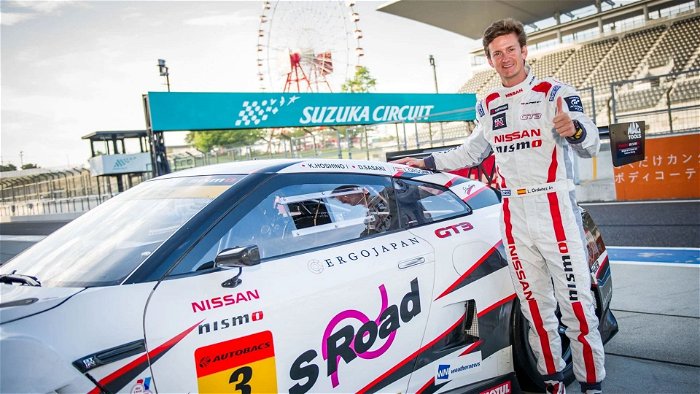As we prepare for the grand premiere of the cinematic adaptation of Gran Turismo, which chronicles the life of GT Academy 2011 winner Jann Mardenborough, it’s an opportune time to delve into the true stories woven into the legend. Jann’s triumphant journey in 2011 has undoubtedly stirred enthusiasm, but the heart-pounding tale of the first gamer to become a professional driver, Lucas Ordoñez, has never been more exhilarating. Before the film illuminated Jann’s thrilling journey, Ordoñez was the pioneer who lived the gamer’s dream—transitioning from virtual racing on PlayStation to tangible victories on the racetrack.
In 2008, Nissan and Sony PlayStation first launched the GT Academy, a competition to turn video game racers into professional drivers. Ordoñez, an avid Gran Turismo player, entered and won, securing a spot racing for Nissan. He scored a podium in the GT4 European Cup in his first year. Since then, his career has taken off, boasting victories in endurance racing, including a second-place finish in the legendary 24 Hours of Le Mans race in 2011 and a third-place finish in 2013, where he teamed up with Jann Mardenborough.

Now, as a major film prepares to dramatize stories like Ordoñez’s, his pioneering journey from PlayStation to pit crew takes on mythic appeal. In this exclusive interview, Ordoñez recounts his experiences jumping from virtual to actual racing, the pressures of competition, and his advice for aspiring racers who dream of following his tire tracks from gamer to winner’s circle. Strap in for a first-hand account of how one Gran Turismo legend beat the odds to become a real-world champion.
Early Passion for Motorsport
Nice to meet you. I’d love to get into how you got this love of racing and motorsport and how you got involved with GT Academy.
Lucas Ordoñez: Everything started when I was very young. My dad loved racing, and he participated in local racing – both in rallies and circuit racing. When he was younger and when my brother was 14, and I was 10 years old, our dad gave us a chance to test a go-kart. That’s when our passion for motorsport began, and you know, the adrenaline of motorsport.
Of course, this sport is very expensive, and it’s difficult to access. We tried our best to get into some races, but you need a big budget to race. I had to stop at some point, but motorsport and motocross have always been a part of my life. I started racing motocross when I was about five years old. I was always there, either behind the wheel or on a bike.
The opportunity finally came in 2008 when the GT Academy started. I was studying in Madrid, Spain. I came across an opportunity in a magazine. Nissan and PlayStation were looking for a video gamer to become a real racing driver. That’s when it all started for me. I was very good at Gran Turismo at the time. I loved playing online and with my friends at home.
When I saw this advert, I went for it. I thought it was the chance of a lifetime, the chance to race. The prize was in Dubai: 24 hours in a race car with ex-Formula 1 driver Johnny Herbert. So I did it in 2008, and that’s when everything started for me with Nissan. My dream came true.

Shock of Transitioning from Virtual to Real Racing
That’s amazing. Now, for anyone who loves Gran Turismo and loves the concept of racing, how much of a change was it going from playing the game, racing these cars that are only dream concepts, to actually getting in there and driving some of the most powerful cars in the world? What was the shock of that transition?
Lucas Ordoñez: Yes, actually, at the beginning, it was very hard when I won the GT Academy. The pressure on all our competitors that week in Silverstone was very high. But you know, the final test during the GT Academy week was to drive a Nissan GTR road Edition on the track, and obviously, the adrenaline, fear, and the feeling of the speed were very big. You know I used to drive on my computer on my PlayStation in front of the screen.
Suddenly I was driving a 600-horsepower car in a real truck with all the risks. The shock was very big, but some of the competitors, we got used to it, and some others have struggled with it. So yeah, it was fantastic for me. I did really enjoy it to feel the adrenaline and the real speed and the risks, and I think that helped me to win the Academy in 2008.
What advice would you give players if they wanted to change positions and make the leap to real racing?
Lucas Ordoñez: Yes. I believe the transition from the simulator to real racing takes a lot of effort that goes beyond the individual driver. You have to maintain an extraordinary level of concentration. The level of concentration required to drive a real car is far greater than that required for PlayStation games, and not everyone can make that transition. However, it’s something that can be worked on and trained for.
Take my experience with GT Academy as an example. When I came out on top, it was not a solo effort. I had a team around me that gave me invaluable guidance on how to deal with the pressure and react appropriately when, for example, lap times in a real car didn’t improve as expected.
So my advice to gamers and online racing enthusiasts is this: You need to excel at PlayStation games, especially Gran Turismo. But it’s also important to be physically fit. The stamina required to drive a car like the Nissan GTR, which has more than 600 horsepower and generates considerable downforce, is considerable. Remember that we often drive in conditions where the cockpit temperature hovers around 55 to 60 degrees. So both physical fitness and mental toughness are essential for real racing.
Gran Turismo and similar games can be a great way to get to know different tracks and improve your driving technique. But when it’s time to get in a real car, you need more than just your gaming skills. You need to be fit, focused and smart. It means making calculated decisions, one at a time, in the right place, at the right time. It’s a game of constant thinking and clever strategy. So yes, being intelligent and adaptable is as important as any other skill in the world of real racing.

Gran Turismo’s Realism Helps Prepare for Real Racing
So now, as you mentioned, Gran Turismo provides you with a knowledge base for tackling the jump. What makes Gran Turismo so unique that it gives you this information?
Lucas Ordoñez: A good example of this was my experience at the Nürburgring 24 Hours. Known as one of the world’s longest and most dangerous tracks, the Nurburgring is a challenge for any racer. My first time there was with Kazunori Yamauchi, the creator of Gran Turismo. My only preparation for this intimidating track, with more than seventy bends and numerous direction changes, was training on Gran Turismo. It would have been easy to get lost.
However, I was able to navigate the track in a real GTR car. When I finished the lap, I immediately thanked Yamauchi for Gran Turismo because I knew exactly where I was on the track at all times, thanks to the game. This is a testament to the accuracy of Gran Turismo’s graphics.
What’s more, the game’s physics are so advanced that even if you’re playing on a screen with a simulator steering wheel, you can feel the nuances of real driving. You can feel the bumps in the road, the car’s downforce, understeer and oversteer. Gran Turismo provides a wealth of information that helps to recreate the feel of every car you drive in the game. For example, I can directly compare a real Nissan GTR GT3 and its virtual counterpart in Gran Turismo. Their lap times, gear ratios and shift points are exactly the same.
This level of detail and accuracy results from Polyphony Studio’s perfectionism. They spend many years developing each game, striving for perfection in graphics, physics and now, with the introduction of GT Sport, the online gaming experience. The online component is particularly complex to manage due to the need to enforce rules and penalties in online racing.
With their efforts now extending to the FIA Championship, they’ve done a remarkable job, and I believe we will all enjoy their offerings for years to come.

Now that you have made the leap, do you have the same or more respect for the cars in these games, or have they somehow been demystified by actually being inside them?
Lucas Ordoñez: Yes, every time you drive one, you gain a deeper appreciation for these machines. Discovering the limits of these supercars like the Nissan GTR is fascinating. It’s amazing how you discover more about its capabilities every time you drive it, and you’re even more impressed by its grip, power and torque.
These cars get faster every year, especially the race cars like the Nissan GTR GT3 that we race in Europe now. Every year we improve our lap times in the championships, and it’s impressive how we keep pushing the limits.
I’ve been lucky enough to drive many different Nissan cars, from the Nissan 350Z in 2008 to the Nissan GT500 in Japan and even the LMP1 car that can reach speeds of over 355 kilometres per hour. Every time you drive a real racing car, you’re in awe of the speed and adrenaline rush, but your aim is always to control, manage, and push it to its limits.

Advice for Aspiring GT Academy Racers
One last question for anyone who wants to follow in your footsteps: what advice can you give them? Is it something that anyone can do, or is it something that you really have to dream about and actually have the ability and the perseverance to achieve?
Lucas Ordoñez: Well, when I won the GT Academy, that’s exactly what I did. I gave it my all. I was studying for an MBA here in Madrid, but when I heard about this opportunity, I put all my focus on it. I spent countless hours training, practising and trying to improve my line.
There’s no magic solution or secret advice to succeed in any sport, especially in motorsport, where the time you spend behind the wheel is so short. You have to be smart and focused every time you drive, whether it’s on the simulator trying to win the FIA GT Championship or in a real race. There’s no room for error.
I advise you to train and work incredibly hard to achieve your goals. For example, if your goal is to win a championship with over 25,000 competitors, you have to strive to shave off every tenth of a second you can.
In today’s Gran Turismo world, there are millions of competitors, and you really need to find consistency in your training. You need to have a plan, aim to be the fastest on a single lap in Gran Turismo and ensure you are consistent and flawless in races.
The only real advice is to work hard and train hard for your goals. That’s the only way to do it. In 2008, I wasn’t as fast as other Gran Turismo competitors, but through consistency and treating training as a job, I was able to match the lap times of the top players.
So yes, there’s no magic formula for anyone here. You have to be dedicated and relentless in your pursuit.
Thank you so much for talking to us today, Lucas! It was fascinating to hear about your journey from virtual racing to real racing through the GT Academy. I really appreciate you taking the time to share your experiences and advice for aspiring racers.




